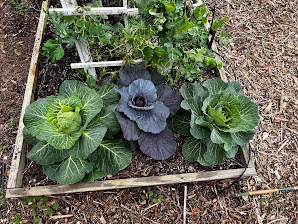We’re all anxiously waiting for the time to plant our spring crops. The gardeners in the VegHeadz garden are worrying about the fall and winter crops which are still thriving in their beds and wondering what to do about them.
Crops like onions, collards, arugula, fennel, dill, and parsley, for instance, present a different problem. Most of these crops will begin to bolt when the weather warms anyway, so cutting them is not a great loss. Or leave some of the ones that bolt and flower to feed spring pollinators. Others will become bug-ridden with pests as garden insects start to wake up and reproduce in the spring weather. Cut those right away.
Wait until it’s time to plant and cut healthy ones off at ground level. The decomposing roots will provide nutrients for your new crops and will make way for air and water to reach the new roots. Save only the best plants that are still producing such as onions or cabbages that have heads still expanding, and cut or pull the rest. Healthy plants can go in the compost bin.
This also provides an opportunity for succession planting. In the space available plant a portion of your spring crops a couple weeks earlier than you usually do, then, as the winter plants start to fade about two weeks later plant some more of the same crop, and then two weeks later, when all the winter vegetables are gone, plant the rest of your crop. That way you can harvest over a longer period of time and take advantage of the most advantageous conditions for the growth of that crop.
Remember, a variety of crops planted in the same bed or area provide advantages at any time, and particularly for the new plants. Existing crops can provide shade and protection to new baby seedlings as they get established, and plants that bolt and flower will attract pollinators and predator bugs to your new plants to help control pests and produce fruit.
For more about preparing your garden beds for the next season, see the plan provided by Nathan Ballantine, the Man in Overalls, here.

No comments:
Post a Comment